Please click here to help David McMurrey pay for web hosting:
Donate any small amount you can !
Online Technical Writing will remain free.
A useful writing tool you'll need, particularly if you are writing for nonspecialists, is definition—or more specifically, extended definition. An extended definition is a one or more paragraphs that attempt to explain a complex term. Some terms may be so important in your report, there may be so much confusion about them, or they may be so difficult to understand that an extended discussion is vital for the success of your report.
Note: See the complete example of an extended definition.
When you write reports, you may often discover that you need to explain certain basics before you can discuss the main subject matter. For example:
- in a report on new treatments for sickle cell anemia, you'd need a section defining the disease.
- In a report on the benefits of drip irrigation, you'd need to write an extended definition of drip irrigation, explaining how it works and what equipment is used.
- In a report showing small businesses how to weather economic recessions, an extended definition of the term economic recession would be needed first.
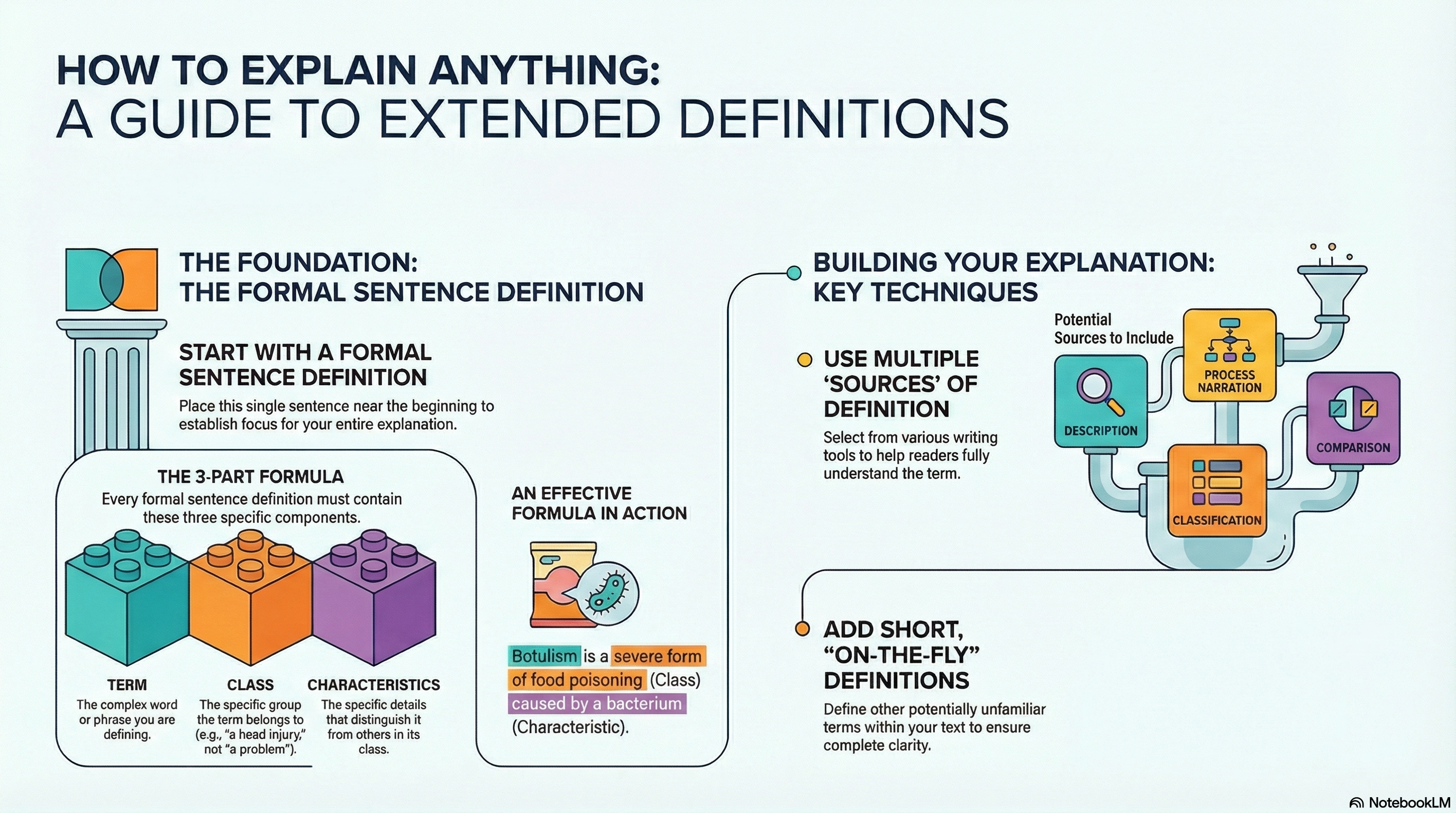 NotebookLM-generated infographic of this chapter
NotebookLM-generated infographic of this chapter
Writing Formal Sentence Definitions
One of the first things to do when you write an extended definition is to compose the formal sentence definition of the term you are writing about. Place it toward the beginning of the extended definition. It establishes the focus for the rest of the discussion. It is "formal" because it uses a certain form. Here are several examples:
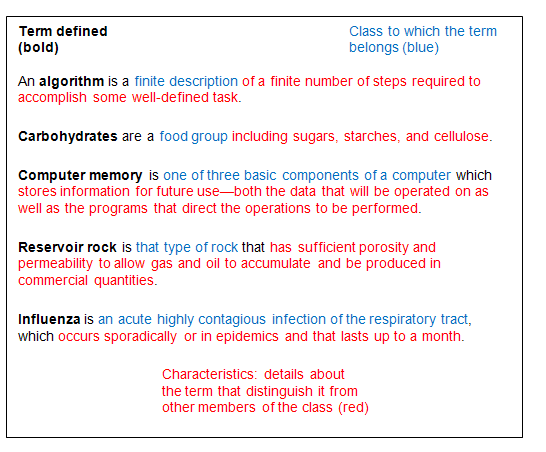
Formal sentence definitions: their components are the term being defined, the class it belongs to, and its distinguishing characteristics.
Take particular care when you write the reference to the class to which the term belongs; it sets up a larger frame of reference or context. It gives readers something familiar to associate the term with. The term may belong to a class of tools, diseases, geological processes, electronic components; it may be a term from the field of medicine, computer science, agriculture, reprographics, or finance. Avoid vague references to the class the term belongs to: for example, instead of calling a concussion an "injury" or botulism a "medical problem," call them something more specific like "a serious head injury" and "a severe form of food poisoning," respectively.
Similarly, provide plenty of specific detail in the characteristics component of the formal sentence definition. Readers need these details to begin forming their own understanding of the term you are defining.
Be aware, however, that your formal sentence definition will likely contain additional potentially unfamiliar terms. Somewhere in your extended definition, you'll need to explain them as well, possibly by using short definitions (explained later in this section).
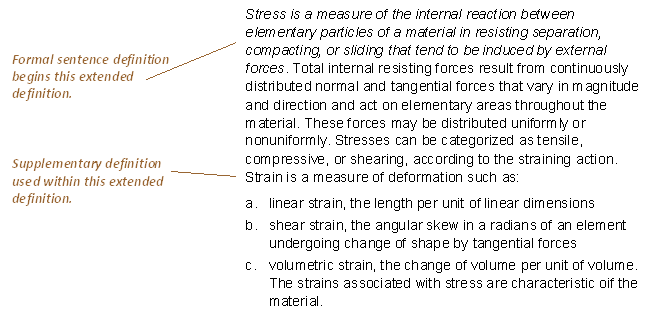
A formal sentence definition used in an extended definition.
Choosing the Sources of Definition
When you write an extended definition, you literally grab at any of the writing resources or tools that will help you explain the term to your readers. This means considering all of the various sources of information that can help define the term adequately (for example, description, process narration, causal discussion, and classification).
Notice how many different kinds of writing are indicated in the examples in this chapter.
The key to writing a good extended definition is to choose the sources of definition to help readers understand the term being defined. Use this checklist to select the kinds of discussion to include in your extended definitions:

Checklist of sources for extended definitions
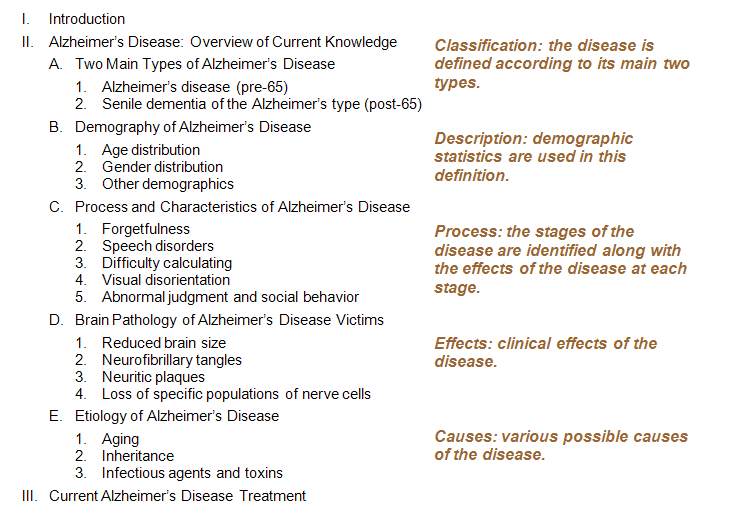
Outline of a report that uses extended definition. This view shows how different sources of definition can be used to write an extended definition.
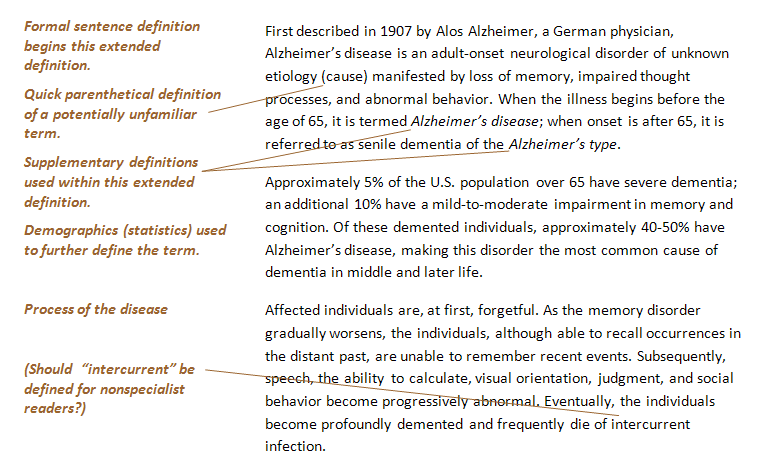
Another extended definition. This one uses additional definitions, description (demographics), process.
Adding Short Definitions
As mentioned earlier, you'll find that in writing an extended definition, you must define other terms as well. Typically, short definitions—a sentence, clause, or phrase in length—will suffice. Notice how many are added to the "after" version in the following.
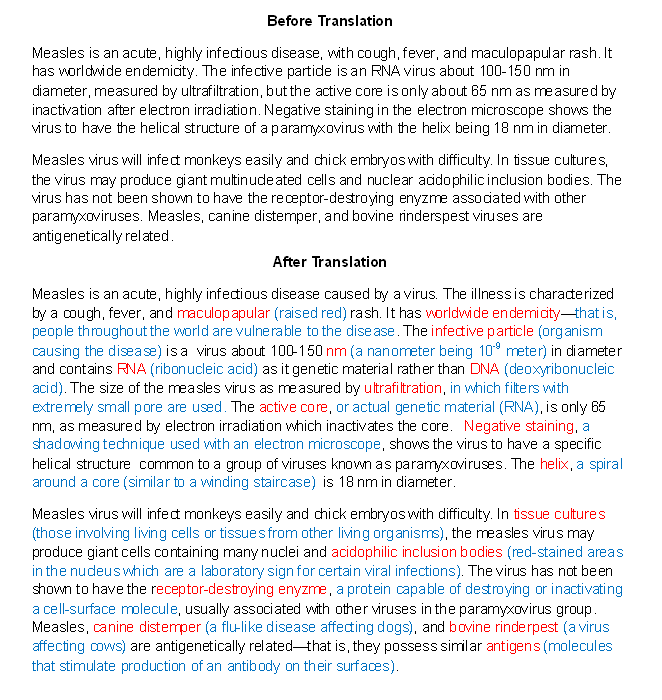
Extended definitions often need
additional definitions. These can be short, phrase-length definitions.
This process of supplying short definitions "on the fly" is critical in good technical writing for nonspecialists. Notice how many quick definitions occur just in the first two sentences of the preceding illusration. "Maculopapular" is defined in parentheses as "(raised red)." "Endemicity" is defined by restating the idea in other words: "that is, people throughout the world are capable of contracting measles." And "infective particle" is quickly defined by providing an alternative: "or organism causing the illness." Obviously, the passage is almost tripled in length—but that's the price for thorough explanation and clarity.
Definitions in Glossaries
In glossaries, as shown in the examples below, the term to be defined is shown in bold followed a period. Some styles prefer lower-casing the term. Notice that the actual definition typically begins with a fragment that includes the category and characteristics.
Generation. The weight of materials and products as they enter the waste management system from residential, commercial, and institutional sources and before recycling, composting, combustion, or landfilling take place. Pre-consumer (industrial) scrap is not included in the generation estimate. Source-reduction activities, such as backyard composting of yard trimmings, take place ahead of generation.
Recycling. The recovery of useful materials, such as paper, glass, plastic, and metals, from the MSW stream, along with the transformation of the materials, to make new products to reduce the amount of virgin raw materials needed to meet consumer demands.
Composting. The decomposition of organic materials by aerobic microorganisms. Composting facilities manage the amount of moisture and oxygen and the mixture of organic materials for optimal composting conditions. The composting process emits heat, water vapor, and biogenic carbon dioxide, reducing the raw organic materials in mass and volume to create compost.
Landfilling. The solid waste remaining after recycling, composting, and combustion with energy recovery. These materials are discarded in a discrete area or excavation that is equipped to receive household waste. In some cases, particularly in rural areas, however, there materials are disposed of on site, or burned on site.
Definitions in glossaries. Thanks to Christopher White for providing this example.
Format for Extended Definition
Extended definitions don't call out for any special format; just use headings, lists, notices, and graphics as you would in any other technical document:
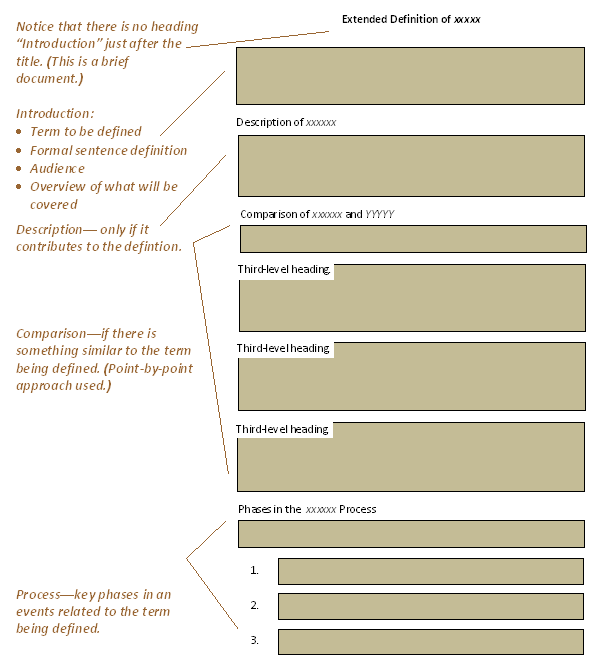
Schematic view of an extended definition. Remember that this is just a typical or common model for the contents and organization—many others are possible.
Something to Consider
What Is Administratium?
The heaviest element known to science was recently discovered by investigators at a major U.S. research university.
Atomic structure. The element, tentatively named administratium or administrivium, has no protons or electrons and thus has an atomic number of 0. However, it does have one neutron, 125 assistant neutrons, 75 vice neutrons and 111 assistant vice neutrons, which gives it an atomic mass of 312. These 312 particles are held together by a force that involves the continuous exchange of meson-like particles called morons.
Behavior. Since it has no electrons, administratium is inert. However, it can be detected chemically as it impedes every reaction it comes in contact with. According to the discoverers, a minute amount of administratium causes one reaction to take over four days to complete when it would have normally occurred in less than a second.

Longevity. Administratium has a normal half-life of approximately three years, at which time it does not decay, but instead undergoes a reorganization in which assistant neutrons, vice neutrons and assistant vice neutrons exchange places. Some studies have shown that the atomic mass actually increases after each reorganization.
Environmental occurrence. Research at other laboratories indicates that administratium occurs naturally in the atmosphere. It tends to concentrate at certain points such as government agencies, large corporations, and universities. It can usually be found in the newest, best appointed, and best maintained buildings.
Toxicity and control. Scientists point out that administratium is known to be toxic at any level of concentration and can easily destroy any productive reaction where it is allowed to accumulate. Attempts are being made to determine how administratium can be controlled to prevent irreversible damage, but results to date are not promising.
Related Information
Writing with Meaning: The Power of Semantics in Technical Writing. This presents the same ideas expressed here.
I would appreciate your thoughts, reactions, criticism regarding this chapter: response—David McMurrey
